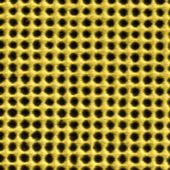
Because of its wave nature, light generally can't squeeze through a hole whose width is smaller than the wavelength of the light. In 1998, however, researchers discovered that light could zip through certain patterns of such holes punched into thin metal plates. Physicists figured out that the light created waves in the metal's electrons--called plasmons--that move across the material's surface in much the same way that ripples move through water. The plasmons, which have wavelengths much shorter than light, couple with each other across the tiny holes and pull the light along for the ride. One possible application is to use plasmons to build better light-based integrated circuits that would be as fast as fiber optics but less bulky.
Toward this end, researchers from the University of Stuttgart in Germany laid very thin films of gold onto pieces of glass and then used ion beams to etch the film with holes arranged in a regular, square array. These holes were smaller than the wavelength of light and, despite being so tiny, are just the kind of openings that have been shown to let light through the thicker, opaque film used in the 1998 experiment. But in the new experiment, the gold film was so thin--only 20 nanometers--that light could already shine through it. And surprisingly, less light went through the holey gold than through the original semitransparent film.
Why? The researchers blame the semitransparent nature of the gold film, which allows 40% of the light to flow directly through it, preventing it from stopping at the surface to help form plasmons. Plasmons are formed by the kick of energy they get from the incoming light, combined with how the electron waves of the plasmons skitter around the hole geometry, so the light needs to be tuned to the specific hole geometry to maximize plasmons. In this case, that leftover 60% of the light simply doesn't combine with the geometry to create plasmons that can cross through the gold holes, the team reports this week in Physical Review Letters.
Physicist Martin P. van Exter of Leiden University in the Netherlands says that interference between hole geometry and light transmission is expected, so the results shouldn't come as too much of a surprise. However, he also points out that gold always absorbs light in peculiar ways--indeed, this is what leads to its golden color instead of most metals' more typical silver--and it's possible that this contributed to the results.
Team member Bruno Gompf says that the next step is to see whether other hole patterns--hexagonal, rectangular, aperiodic--show the same effect. Perhaps a particular pattern could serve as a filter to block certain wavelengths of light in those future plasmonic integrated chips, he says.



Reader Comments
to our Newsletter